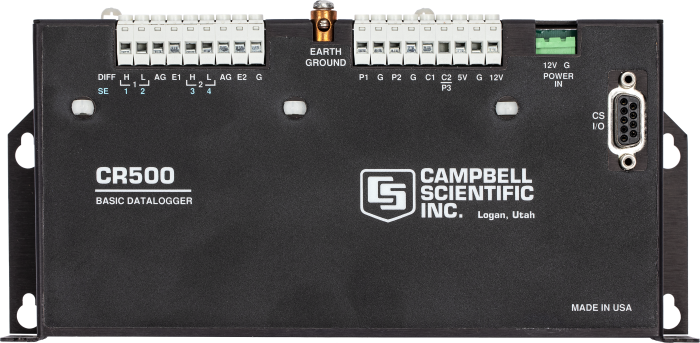This product is no longer available and has been replaced by: CR800.

| 利用できるサービス | |
|---|---|
| 修理 | 非対応 |
| キャリブレーション | 非対応 |
| フリーサポート | 非対応 |
概要
The CR500 provided four single-ended (two differential) analog inputs, two pulse counters, two switched excitation channels, and one control port. It used the CR10KD for on-site interrogation, as well as the same power supplies, sensors, and communication methods as the CR10X.
続きを読むイメージ

詳細
The CR500 provided four single-ended (two differential) analog inputs, two pulse counters, two switched excitation channels, and one control port. It used the CR10KD for on-site interrogation, as well as the same power supplies, sensors, and communication methods as the CR10X.
PC208W versions 2.3 or greater provided EDLOG support for those customers whose applications required programming beyond the scope of Short Cut. It required PC208W or PC208 for non-direct communications.
仕様
| Analog Input Channels | 4 single-ended, 2 differential |
| Switched Excitation Outputs | 2 |
| Input/Output Control Ports | 1 |
| Pulse Count Channels | 2 |
| Serial I/O Port | 1 |
| Memory | Stores up to 62,000 data points in internal memory. |
| Standard Operating Temperature Range | -25° to +55°C |
| Extended Operating Temperature Range | -55° to +85°C |
よくある質問
CR500に関するよくある質問の数: 3
すべて展開すべて折りたたむ
-
The CR500 has battery-backup RAM. If power is lost, final storage data is still retained. When power is restored, final storage data can be accessed. There is 64kB for final storage data grouped in four 16kB sectors. When memory is full, the 16kB sector with the oldest data is completely erased. The new data is stored in that sector.
-
The CR510 has all the channels, features, and instructions that the CR500 has, in addition to the following:
- The scan interval resolution is 1/64 in the CR510 and 1/8 in the CR500.
- There is a Final Storage Area 2 in the CR510 that is not in the CR500.
- There is a battery-backed clock in the CR510 that is not in the CR500.
- The CR510 has 128K Flash and 128K SRAM memory. The CR500 only has 32k SRAM and 128k Flash.
- There are several programs in the CR510 that are not in the CR500.
- There are 1 MB and 2 MB memory options for the CR510 that are not available for the CR500.
- Available operating systems in the CR510 were Standard, Modbus, Alert, Table Data. and PakBus. Only Standard Operating Software and Alert were available for the CR500.
-
Communication is done through the CS/IO port on the CR500 at 300, 1200 or 9600 bits per second, 8 data bits, no parity, 1 stop bit and no flow control.
Privacy Policy Update
We've updated our privacy policy. 詳細はこちら
Cookie Consent
Update your cookie preferences. クッキーの設定を更新する